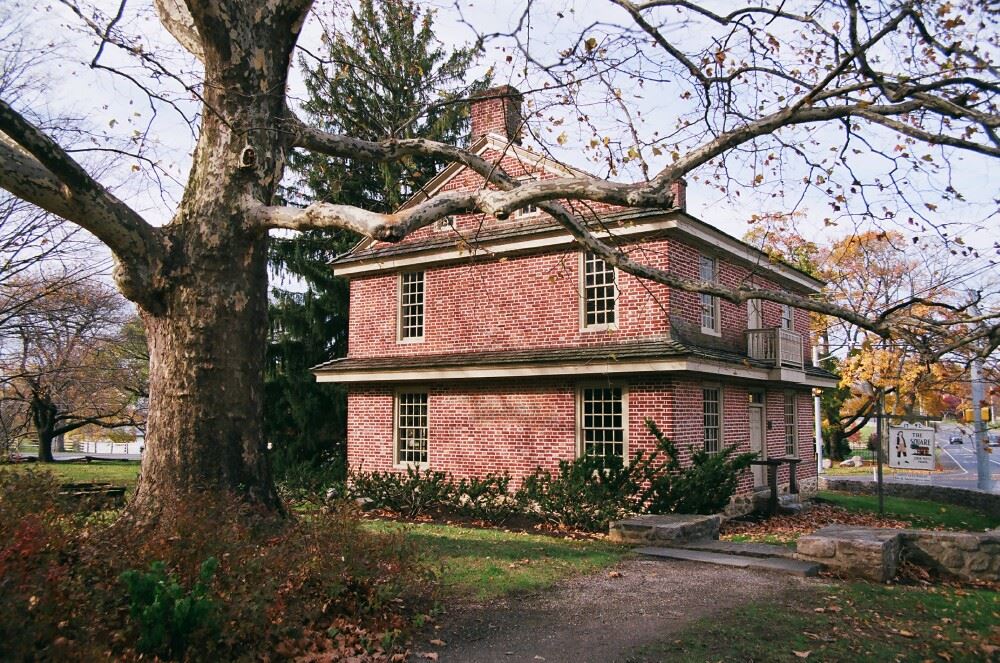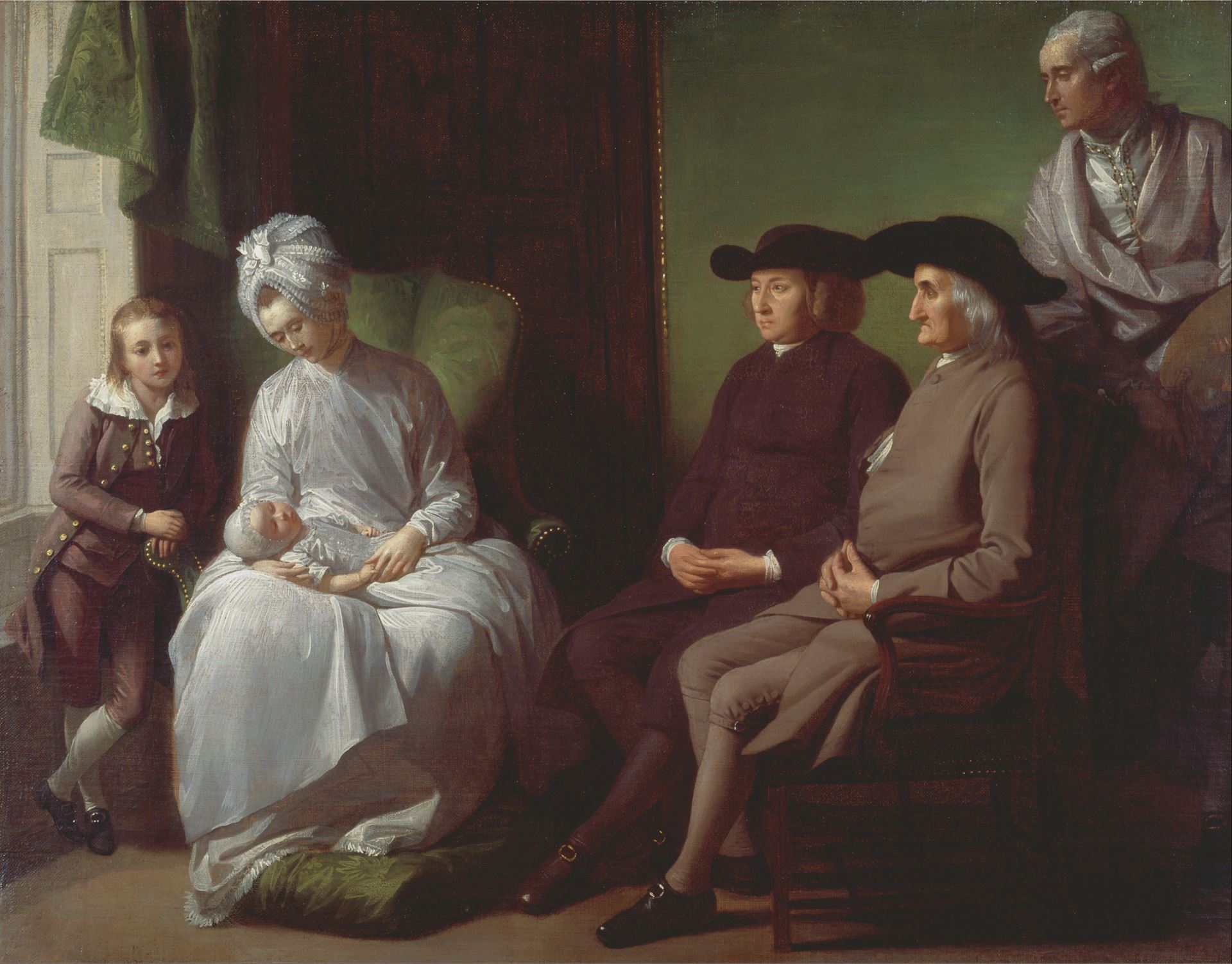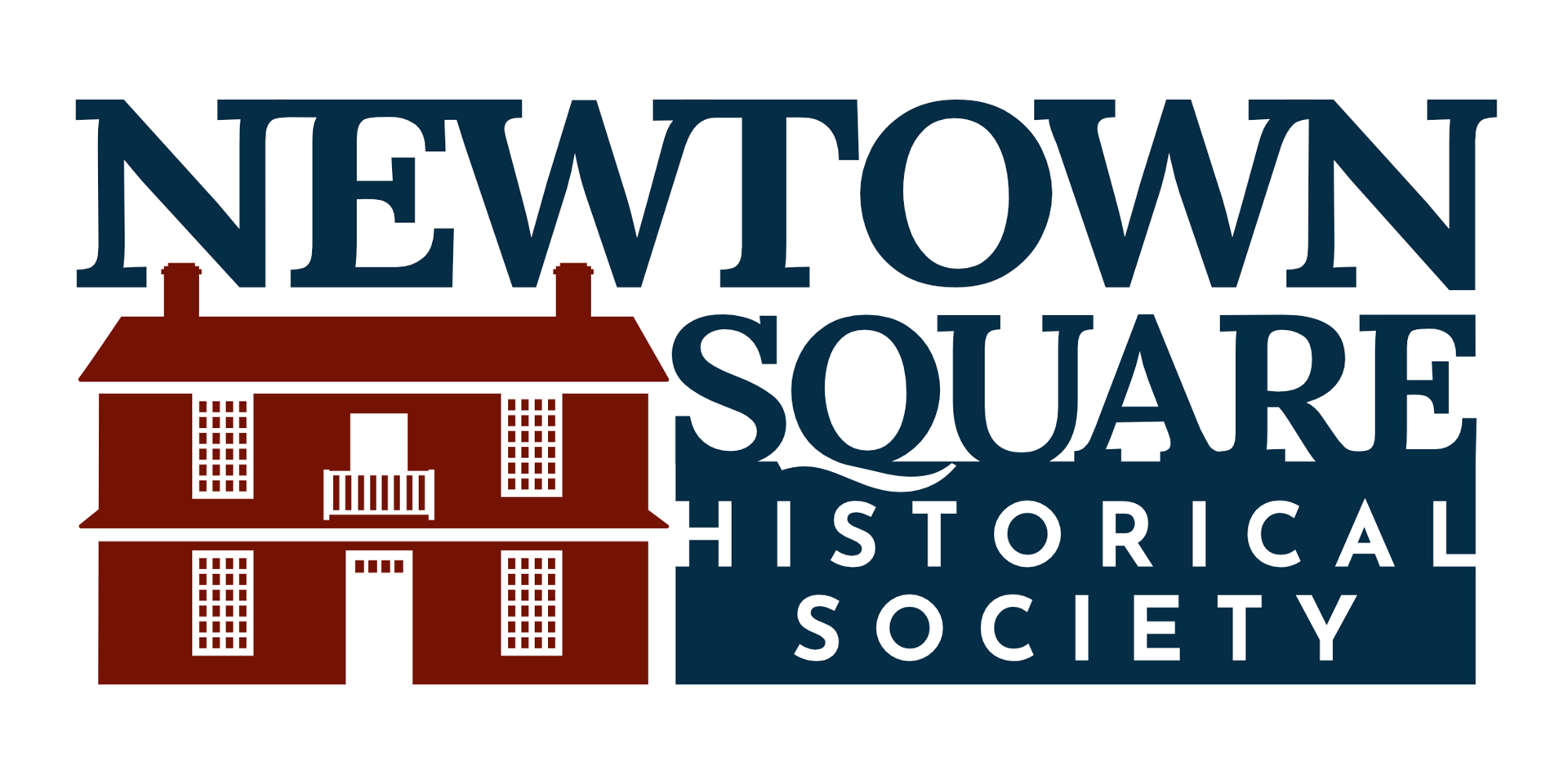
The Square Tavern
Is open periodically throughout the year, and now houses both the Benjamin West Gallery. Check our Event Listing for special events. Group tours may be available by appointment.
One of the most important extant buildings in Newtown Township, due to its association with the internationally famous artist, Benjamin West, is the building known as the Square Tavern. The artist’s father, John West, was host and lived there with his family intermittently between 1744 (when Benjamin was 6 years old) and 1758.
The Inn or Tavern stands at the corner of Goshen and Newtown Street Roads, the Central Square of the town. The fact that the preserved section was built in 1742 by Francis Elliot may be ascertained by examining several 18th century Chester County Tavern License Petitions. Apparently by November 24, 1741, Francis Elliot “of the Township of Newtown” (Chester – later Delaware) County, was living in a house situated on the corner where the Square Inn now stands (probably, in back of the part now standing). This is evidenced by Elliot’s 1741 Petition, in which he is requesting a “license… to keep a publick House of Entertainment, at the Intersection of Darby (Newtown Street) and Goshen Great Roads.” He complains that “your petitioner is frequently burthened with Travelers on the Sd Roads and the approaching season of the year (is) like to mate it more So to be.”
Above the signatures of subscribers is written: “We whose Names are hereunto Subscribed do Certifie on behalf of the above said Francis Elliot, that the place he Dwells in Is convenient place for a Publick house of Entertainment and that there is great occasion of one in that place.”
Attached to this Petition is a roughly-sketched map or drawing indicating the location of “Francis Elliot’s house” with the explanation that It is 2 miles from “Joseph Hally’s house (Hawley’s Tavern, later known, as THE FOX CHASE INN) “on Darby Road” (today a part of West Chester Pike).
In spite of the arguments set forth in Francis Elliot’s Petition of 1741, it was refused or “disallowed.” The petition made by Joseph Hawley of “Hallys House” (now FOX CHASE INN), mentioned above as being 2 miles from “Elliots House,” (later SQUARE INN area), explains who led the opposition against Elliot and why Joseph Hawley was the original (1727) operator of the HAWLEY TAVERN on the north side of West Chester Pike, a quarter mile east of Newtown Street Road.2 Fourteen years later, Hawley and his wife, now elderly, feared competition from a new tavern approximately 2 miles away. The Hawley Petition of 1741 also explains why Francis Elliot was named the “builder” of the tavern:
… your said Petitioner {Hawley) haveing for these fourteen years last past Behaved himself as an honest Civill and quiet Neighbour in his said Imploy, (forbidding Gameing or Drunkedness or Suffer mens sen ants of others to sitt tippling in his house and he and his wife being each of them Between Sixty and Seventy years of age Prays that the Honourable the Bench of Justices will be pleased to take this his Petition unto your Wise Considerations and hope you will not allow Francis Elliot a Young Man (that hath a good trade being a wheelwright house carpenter and joyner haveing a wife, and one child hath two or three apprentices one Journeyman) to obtain your Grant for keeping a public house in Newtown aforesaid to the Great hurt and damage of your Petitioner in his old age , . .
Hawley was successful in obtaining his license that year (1741) and in preventing Elliot from receiving his. However, Elliot did not appear to be discouraged for the next year, on August 31. 1742, he was again petitioning to “keep a publick house of Entertainment were Your Petitioner Dwells,” adding that “by the Desire of Some of the Subscribers to your Petitioners Certificate annexed have been Encouraged almost to compleat a large Brick Building and in a Short time (by the Providence of God) shall he finished. So your Petitioner Shall have additional Convenience for the reception of Travellers.”
Evidently, Francis Elliot did not own the house in which he lived at the corner of Goshen and Newtown Street Roads but rented it and the “large Brick Building”4 which he built as an addition or nearby structure was also rented. The owner of the properties at the time of The Square Inn’s construction was WILLIAM LEWIS III (1708- c.1758) who married Susanna Jones in 1732.5 William Lewis’s neat signature appears on Francis Elliot’s Petitions of 1741 and 1742.
In August of 1743, Benjamin West’s father, John, petitioned for a license to operate a Public House of Entertainment. Unfortunately, the Township in which the tavern was located was not mentioned and historians are not in agreement on its location. Lucy Simler, who has made exhaustive researches in the field of early taverns in Delaware County, has written, especially for this book, the following explanation and clarification of this subject:
John West, father of the artist, had kept an inn in Chester, on the green near the court house, in 1733. Before Benjamin’s birth in 1738, the family moved to Springfield Township to what is now known as the Benjamin West House on the Swarthmore College Campus.6 In 1743, John West again petitioned the Court for a license to keep tavern. Was this tavern in Springfield or Newtown?
The petition itself is ambiguous. West stated that he had rented a ‘Comongas house and all other the Conveniences there and to beloning for house of Entertainment on the Roade leading from Darby to Springfield an from thence to Conistogo.’ An inn so described could be located in Springfield or on Newtown Street Road. The latter was often referred to by those traveling from Darby to Conestoga as the Darby Road. In his petition of 1741, Elliot had departed his tavern as located at the intersection of Darby and Goshen Great Roads.
The difficulty is compounded by the petition of West in 1744. This petition states:
… that whereas your petitioner by virtue of your Recommendation has obtained ye Lycence from the Honourable Governor for the keeping A publick House of Entertainment in the County of Chester for one Year which being now Expired Your Petitioner Craves to be continued in the same Station in the township of Newtown in sd. county the Ensueing year…7
“The temptation is to argue from the second to the first petition when trying to date Benjamin’s arrival in Newtown. Knowing that John West was host at the Square Inn in 1744, the reader is apt to infer from the phrase ‘continue in the same station’ that West was also there in 1743, that the tavern of the 1783 petition was The Square.
However, to do so is to ignore the signature of those who signed West’s petitions and attested to his character. The men who signed in 1743 were from the Springfield area, those for the second petition, from Newtown. Generally, these signatures are a reliable clue as to the tavern’s location. (Tavern petitions are generally signed by residents of the neighborhood in which the tavern is located.) Perhaps ‘station’ should be understood as referring to a station in life. West could merely be asking to be allowed to continue in the same employment.
Lucy Simler’s arguments give substantial credence to the theory that John West was petitioning in 1743 to be host at the Springfield tavern. Therefore, it seems to have been established that John West did not become host at the SQUARE INN at the corner of Goshen and Newtown Street Roads, Township of Newtown, until 1744, when his son, the future artist, was approximately 6 years old.
The tavern building itself, “completed” late in 1742 by Francis Elliot and his apprentices, has undergone many changes and additions through the years. A thick and clinging stucco was placed over the exterior of the building sometime before 1897 when Rev. Hotchkin wrote his book entitled RURAL PENNSYLVANIA. The Rev. stated (on page 384) that the SQUARE INN was substantially built of brick burned in the field adjacent.” (This would be on the southeast corner of Mrs. J. Austin du Pont’s LISETER HALL FARMS estate, just across Goshen Road from the inn.) In an interview with Mrs. du Pont’s son, John in 1980, he stated that he did not know of any signs of the kiln ever having been discovered but asserted that there could easily have been one on that spot.”
An excellent job of restoration on the Inn was completed at the end of January,1981, the work being done under the supervision of General Contractor, David .Abel, working with the John Milner Associates under the sponsor ship of then owners, ARCO CHEMICAL RESEARCH CO., INC. Dedication of the restored building took place on February 1, 1981. A possible reason for the early application of thick stucco may lie in the fact that, as General Contractor Abel discovered, the bricks were of an inferior quality. This was revealed on the exterior when the stucco was chipped away—and on the interior walls as well. Rev. Hotchkin had mentioned (also on page 384) that the interior walls were made of the same “home-made” brick. This statementwas confirmed during restoration when the plaster covering on the inside walls was removed. The walls were crumbling and had to be replaced by plaster-covered cement blocks to prevent the floors from collapsing.
The poor quality of the bricks may have been caused by the fact that brick-making was not customary in this area- In a paper distributed at the restored Inn dedication, on February 1, 1981, it is stated.’ “The John West House is … important as a brick structure in a region where stone construction predominates … Most brick dwellings built before 1750 tend to be closer to the Delaware River than this example …” According to Mr. Abel, not only were the bricks inferior but Francis Elliot and his “apprentices” were poor craftsmen as well. Slides taken during the restoration work gave definite proof that the brick and other construction were “out of line.” Mr. Abel suggested that this might be ascribed to the fact that, as shown in the 1741 Hawley petition, Francis Elliot, being a wheelwright and joyner as well as house carpenter, may have been a “Jack of All Trades” and proficient in none!
However, Mr. Abel and his fellow-craftsmen did an excellent work of restoration. A pent roof around the front of the building, which had been eliminated when a porch was added, was replaced as the porch was removed. Evidences of a balcony were found, and it was reconstructed in the middle of the pent roof above the front door. It was discovered that many of the windows had been larger originally. They were re-built to the 12 panes over 12 earlier size. A large walk-in cooking fireplace was uncovered and restored in the room in back of the front “tavern room.” Marks of an oblong open space through which dishes had been passed between the “dining-room” and “kitchen” were found and caused this interesting detail to be re-instated. It was in this tavern or dining-room where we can imagine the hustle and bustle as John West, in the days when he was “mine host,” presiding, the aroma of meat being roasted over a blazing fire in the kitchen fireplace, slices of meat and other food being passed through the “window,” ale being poured into pewter mugs for the drovers. The Square Inn was an important stop on the Conestoga-wagon route from Philadelphia west to the Lancaster-"Conistoga" area.” 11 The restoration has brought back the original floor-plan construction with four rooms downstairs and four above. The room on the left in back downstairs may have been used by the West or host family as a dining-living-room and occasional overflow room for guests. The room on the left front poses questions. It shows no indications of ever having had a fireplace. Was this room used for storage of foods in winter and as an extra dining-room in summer? No one knows. Upstairs were 4 rooms for sleeping. It is known that a number of guests sometimes slept in one room in 18th-century inns, piles of straw on the floor serving as beds for some of the men. One of the rooms may have been reserved for the West or host family while the attic may have served as sleeping quarters for the numerous West children.
The sign which hung outside of the inn was similar to the replica which may be seen there today, The present sign (a double-faced one) was painted in the fall of 196912 by Carl Lindborg for the then Marple-Newtown Historical Society, after carefully researching types of Philadelphia-area signs and posts of the early 1740’s. Mr. Lindborg also researched the name of the inn. We know mat the inn was known in 1755 “by the sign of The Square” and that it continued by that name at least until 1771, for in the Pennsylvania Gazette for August 14th of that year, the following notice appeared: “Newtown Square. Chester County, Pa. … To be Lett, and entered upon immediately. The noted House and Store, formerly occupied by James Mecan, right opposite the Square Tavern, supposed to be as public a place for a store as any in the County. For particulars Enquire of John Jarvis, at the Square.
(Excerpted from the book "Historic Newtown Township (Newtown Square, Delaware County, PA) 1681-1983" by Alice Lindborg, et al.:)
Benjamin West's Ancestry
Benjamin West was born October 10, 1738 in Springfield Township. Chester (later Delaware) County, Pennsylvania, youngest of 10 children born to John West and Sarah Pearson West. Benjamin’s father, John, was born a birthright Friend in 1690 in the Parish of Long Creedon in Buckinghamshire. England. John’s father was Thomas West and his mother’s maiden name was Rachel Gilpin. As a young man, John was a cooper living in Wapping, East London. His first wife was Elizabeth Beislay of Warborough, Oxford, England. She too was a birthright Friend. This information is from a paper read by Albert Cook Myers at the Springfield Meeting in Marple in 1929.14 In the paper, Mr. Cook mentioned that a son, Thomas, was born in 1716 of this first marriage, adding that the wife dying about this time, John joined some of his brothers in Pennsylvania. However, in another account, Charles Henry Hart15 wrote that John emigrated to Pennsylvania circa 1715, having left his wife in England, where soon after she died while giving birth to a son, Thomas. If true, the second account could explain why John was not in good standing with the Friends in England and left without a certificate of transfer. It would also explain why, when John West married Sarah Pearson in 1717 or 1718 in Pennsylvania, she, who had also been a birthright Friend, was “read out of Meeting.” Lucy Simler in the February 1979 letter referred to before, suggested that John West may have “continued to …set a Quaker tone. His neighbors referred to him as a Quaker in the 1740’s when he definitely was not . . . (and that) after (his wife’s) death, John …”made peace.” However, John and Sarah were not technically members of the Meeting while Ben was growing up, so Benjamin cannot be termed a Quaker.
Benjamin West’s mother’s parents were among the early settlers in this area. They were both Quakers from the township of Pownell Fee, Wilmlow, Cheshire, England. Young Thomas Pearson and Margery Smith Pearson, his bride (a sister of Mary, Daniel Williamson’s wife) came to the new country on the ketch ENDEAVOR, arriving in September, 1683 as did Daniel Williamson. Thomas was a mason. Albert Cook Myers, in his 1929 paper, made it clear that there was no substance to the rumor that Benjamin West’s grandfather, Thomas Pearson, came over on the ship WELCOME with Penn and suggested the name CHESTER instead of UPLAND. Pearson did not arrive until a year later than Penn and by that time the name CHESTER had been established."
(Excerpted from the book "Historic Newtown Township (Newtown Square, Delaware County, PA) 1681-1983" by Alice Lindborg, et al.)
Self Portrait with Family (1772)

Contact Us info@nshistory.org • 610-975-0290 • P.O Box 3, Newtown Square, PA 19073 The Newtown Square Historical Society is a community volunteer organization. We get our principal funding from you, our members, patrons, neighbors, and friends. Without your support, we cannot do all that we do. We are a 501(c)(3) charitable organization, and your donations are charitable deductions as permitted by law. ©2025 Newtown Square Historical Society |
